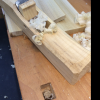This instrument was popular in the later 18th.C. for ladies to play. It is a very decadent instrument,in my opinion. It is tuned in an open C chord,and is about the simplest instrument ever devised to learn. That is why it was popular. In those days,a music teacher would travel around,teaching the English guitar,or perhaps spinet or recorder(a type of woodwind). He would go to a wealthy plantation,or a house in town,and would stay with the family while he taught music to the young ladies in the family.
Unfortunately,I have only a bad slide of the English guitar with the rose. The rose is the only thing worth noting anyway,though it is too bad the tuning mechanism can't be studied.
The less colored picture is of the first instrument I ever made for Williamsburg,a little out of focus. It is another English guitar with a rose shaped like a low cone. It is an exact copy of one from the collection,and might have been sort of a test at the beginning of my employment. The next instrument was the large harpsichord (a considerable jump!)
The English guitar is really a late type of cittern. It sounded more like a mandolin than anything else,having no resemblance to the true guitar(which took much more effort and practice to learn.)
It has wire strings. This example has the patent tuner,which made it a LOT easier to tune,since wire strings are MUCH more sensitive to tune than gut strings(wire doesn't stretch much. Gut gives a bit of built in "gear ratio" to tuning).
This patent tuner was full of parts,and no one on my staff ever wanted to make one. You can make them with only hand tools. There is a silver plate with 10 thin slits in it.Beneath each plate is a steel screw about 1/8" in diameter. Each string is attached to a little metal string holder,which is threaded to the screws beneath. You use a pocket watch key to turn the screws to tune the strings to CEGceg.
The tuner was a pill to make.
The rose of this English guitar is exactly the same rose I made for the marquetry lute that I have never posted here,but will,when I get some decent pictures of it. It is made of 1 piece of boxwood,and is 4" in diameter. I had gone to the trouble when I first made the lute,to make a brass template for laying out the segments of the rose,and a template for laying out the vines. Each flower is different,and those were hand drawn in every time. Then,all was sawn out,and carved rounded and 3 dimensional.
I know I made this instrument,but have NO recollection of carving that 2nd. rose(or making the guitar) AT ALL. But,it is my rose,and no one else on my staff could carve it.
The instrument is all maple,with a spruce top. In the late 18th.C.,ridiculously complicated,and very clunky attachments were made for this instrument. There was an oval box containing a little keyboard with 5 keys. Each key had a little piano escapement that would strike its given string,making the instrument sound like a little spinet,or piano. Must have cost a fortune!
They also used an early form of capo. But,instead of harmlessly clamping around the neck,off set holes were bored through the neck for a metal screw. The head would be on the back of the neck,while the capo's cross bar,with wingnut,was on the front. This way,the young lady did not have to learn to play in different keys. HOW DIFFICULT!!! I mean,this was a very elementary instrument to play,so your daughter could look like she had SOME talent.
Well,we made a bunch of these things in the museum.





 Reply With Quote
Reply With Quote







